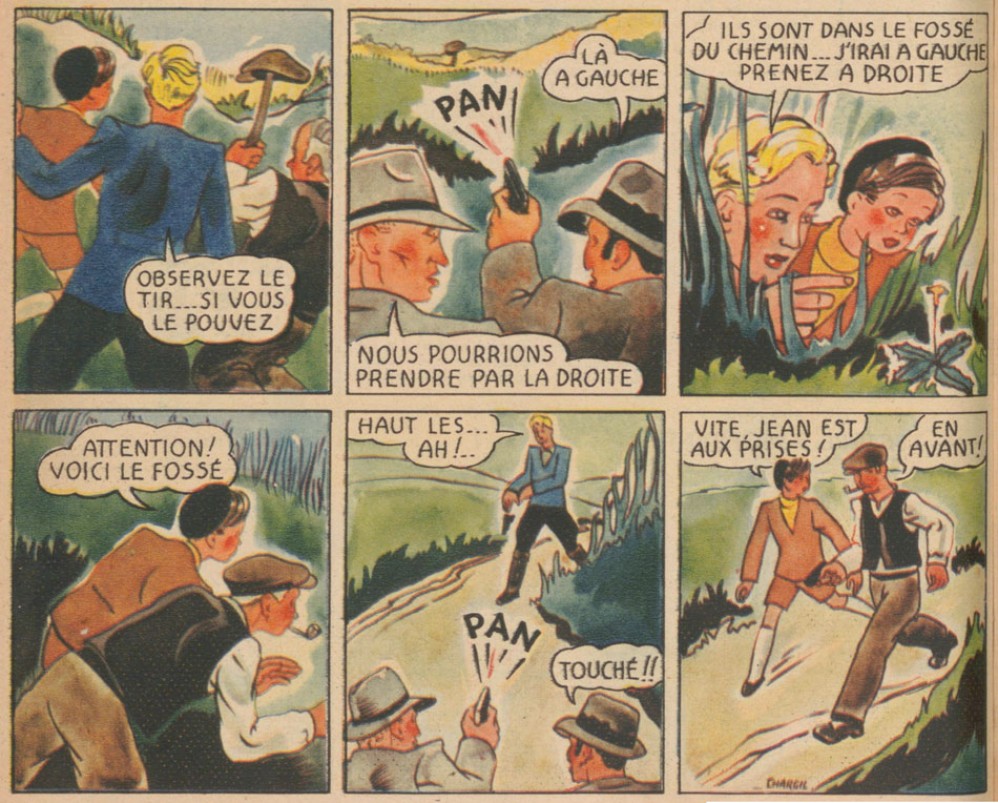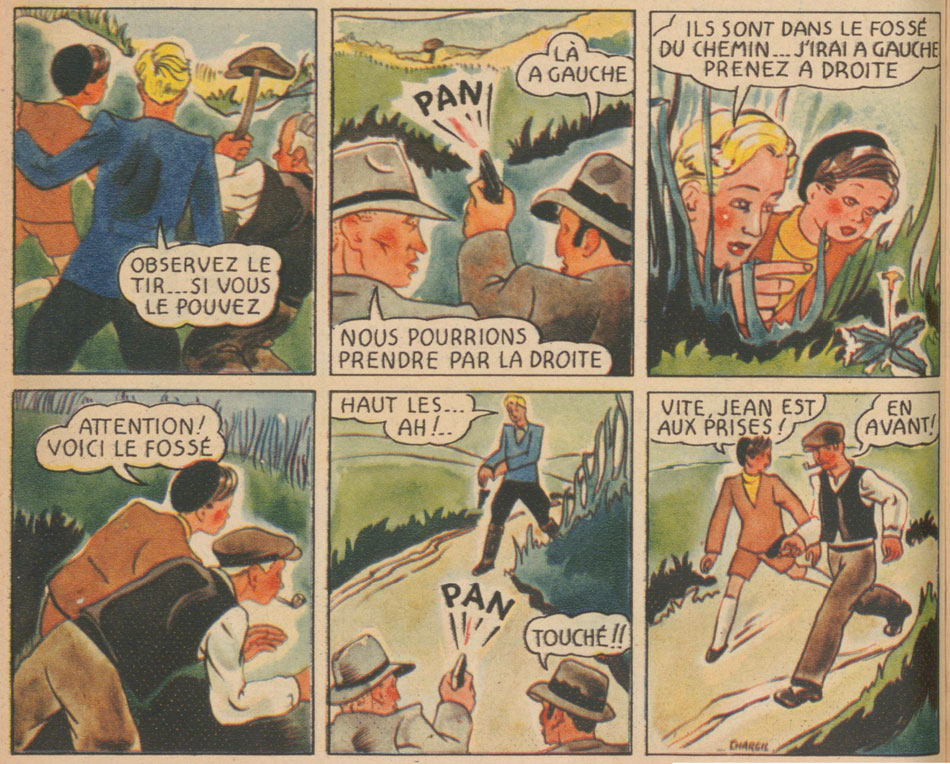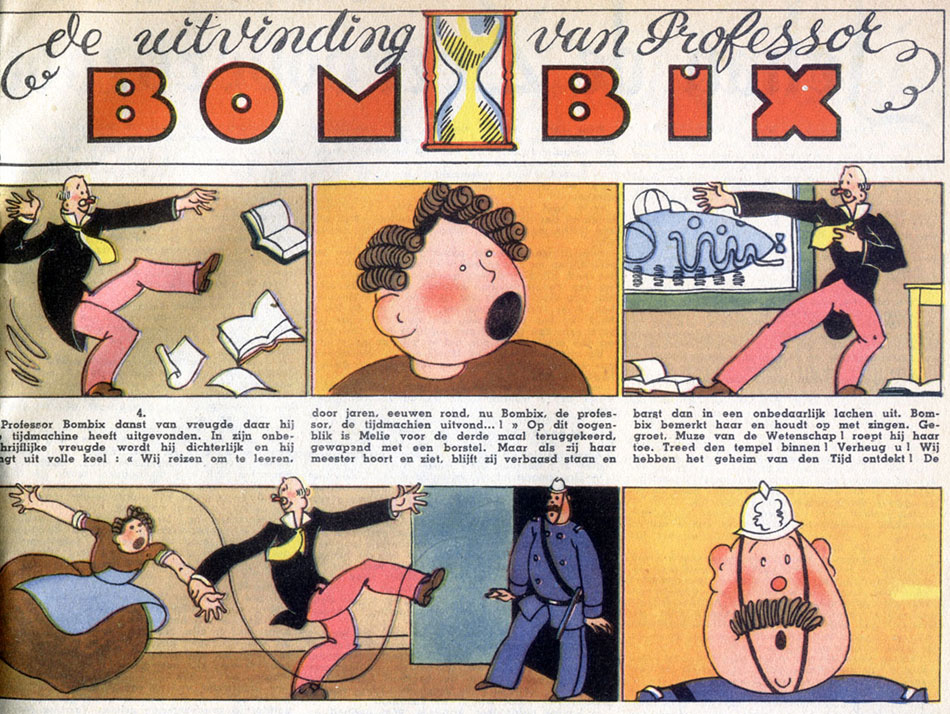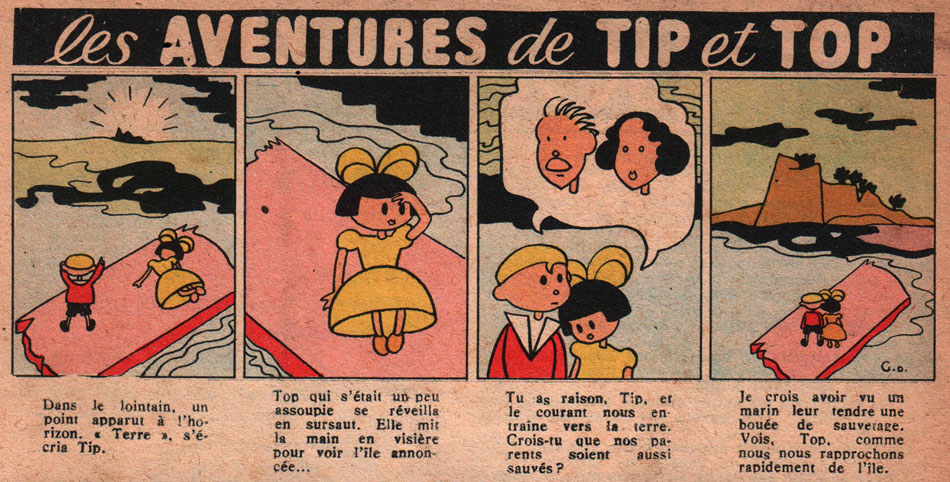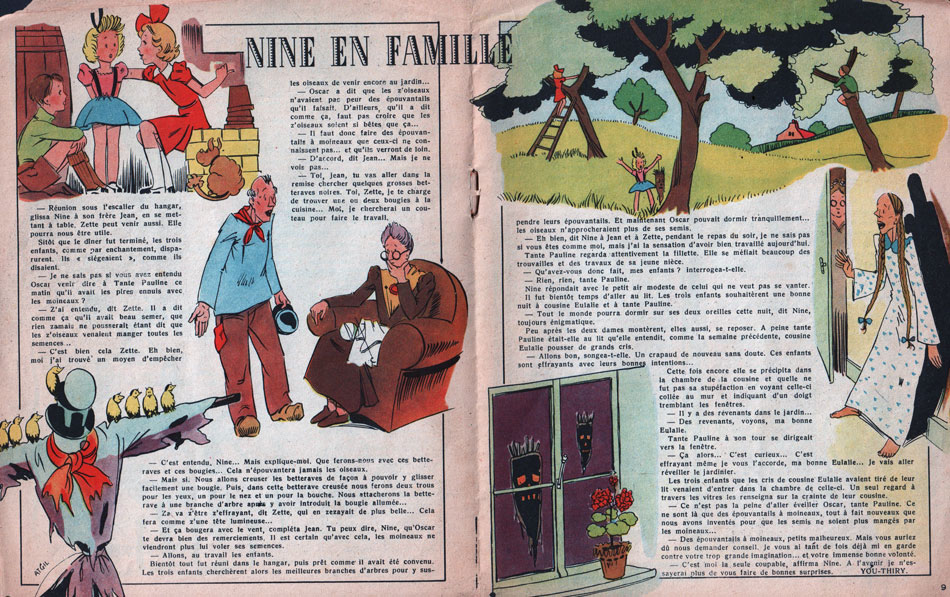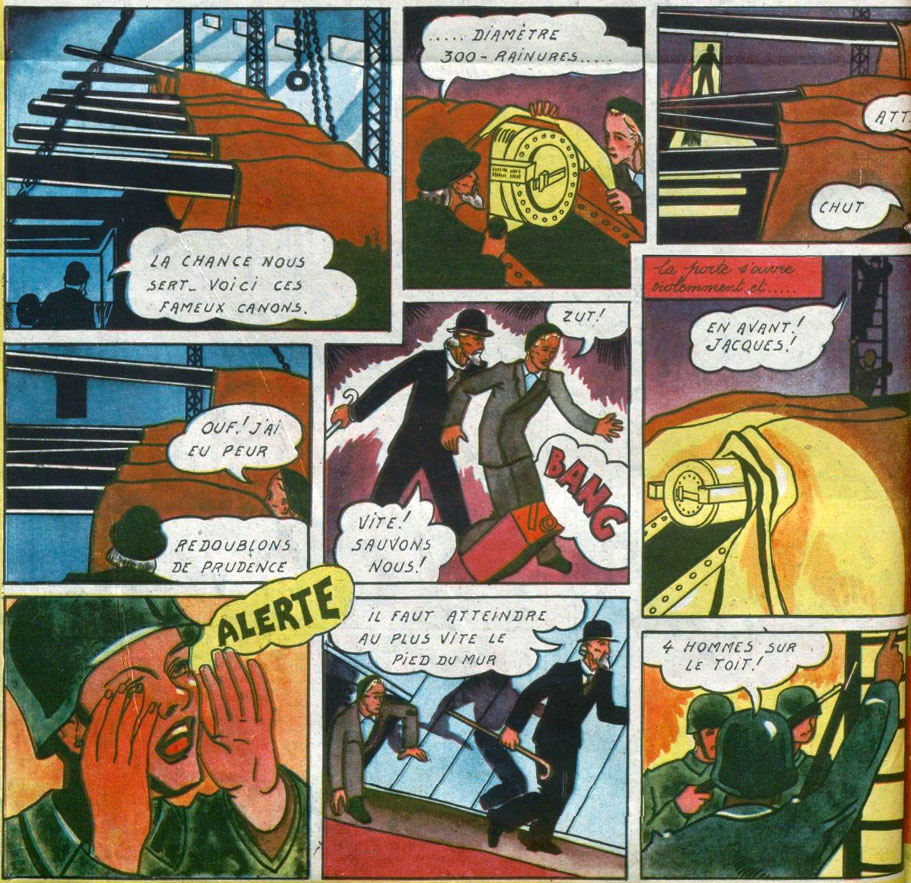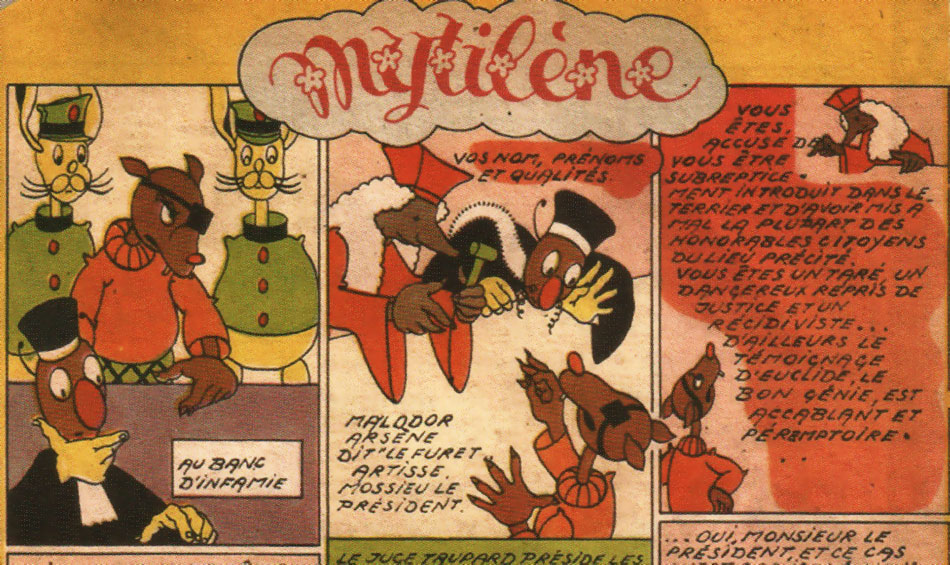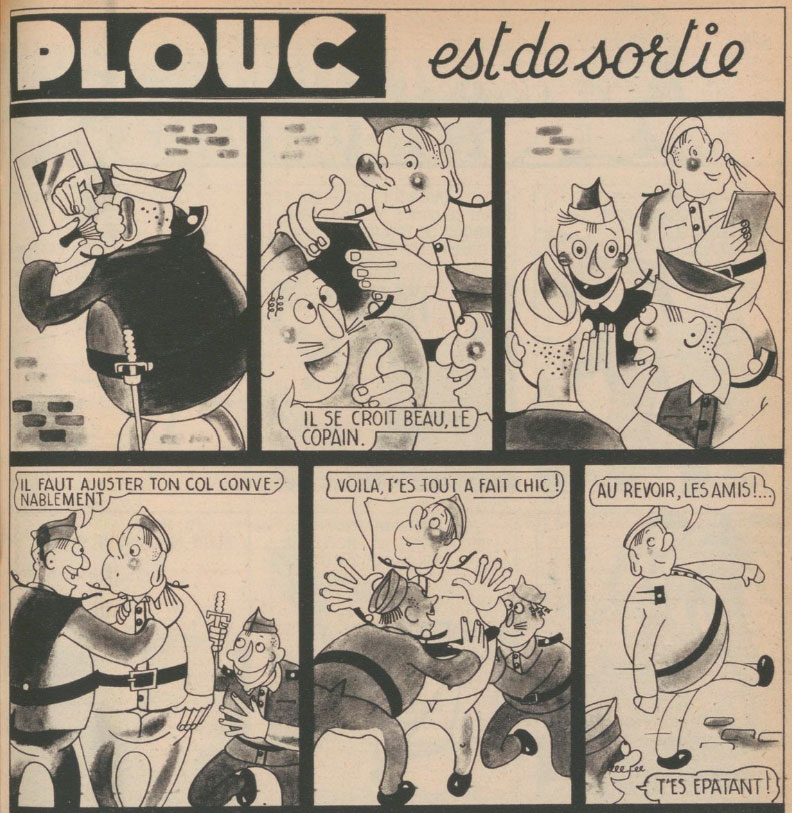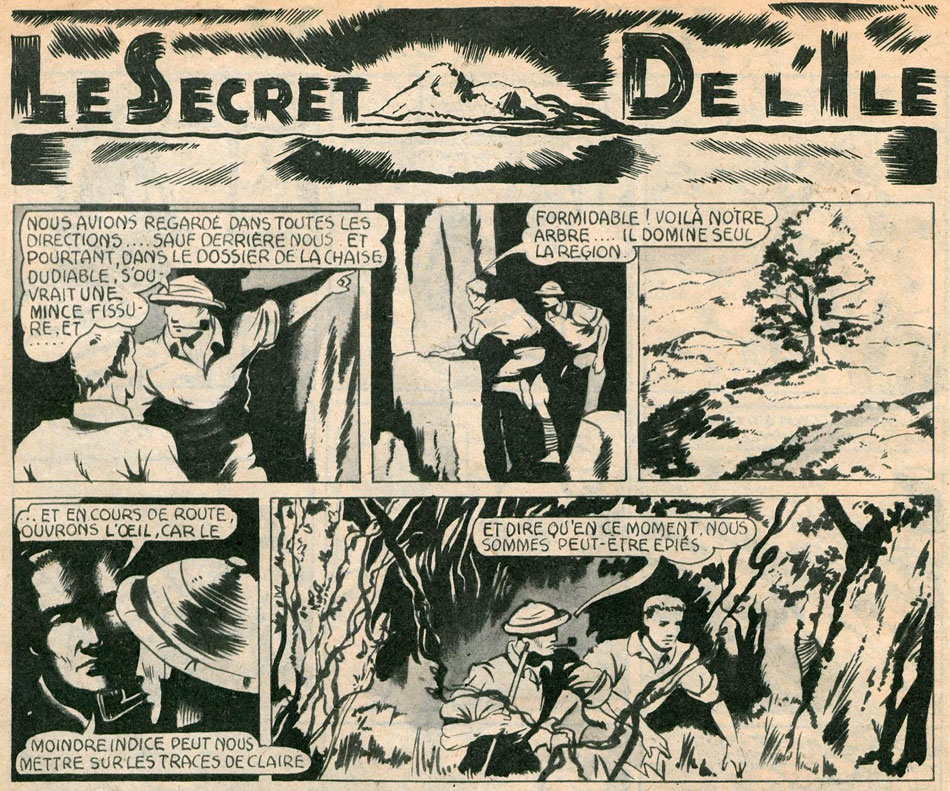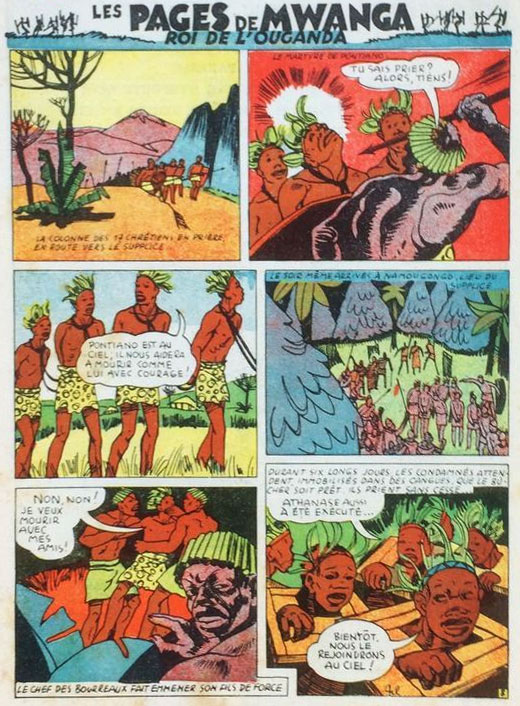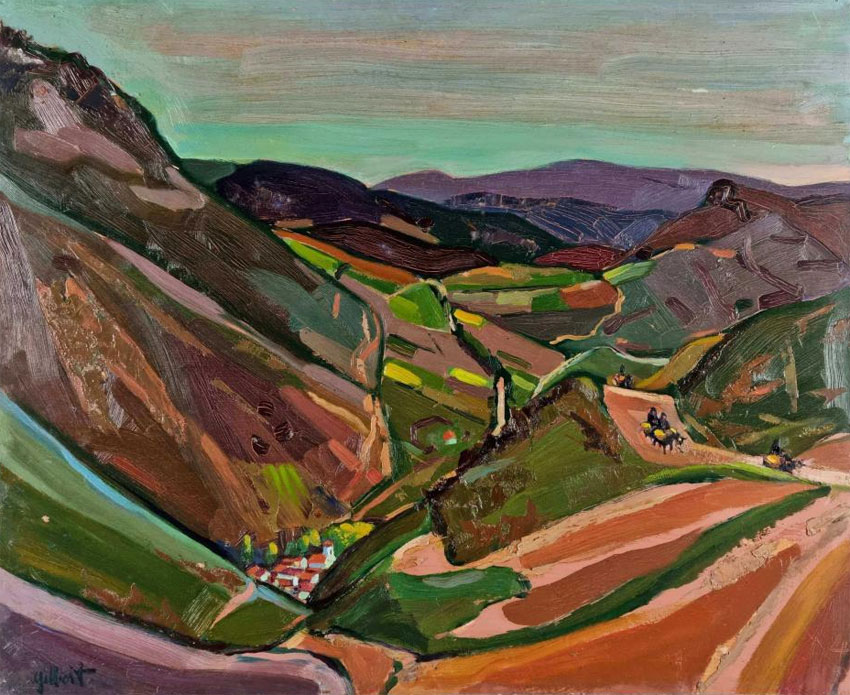'Dans les Griffes de la Gestapo' (Grand Coeur #5, 17 January 1946).
Charles Gilbert was a Belgian expressionist painter, illustrator and comic artist, who mostly worked under the pen name Chargil. Together with his atelier of students (known as "At-Gil" or "Imagil"), he was a prominent illustrator in a great many Belgian youth magazines of the 1940s. His comic stories appeared in Bravo!, Nine, Wrill, Petits Belges and his own magazine, Grand Coeur (1945-1947). Versatile and omnipresent, he could have been the founder of a Liège school of comic creators, but the magazine market and his own artistic ambitions directed him to other endeavors.
Early life and career
Charles André François was born in 1906 in the Brussels suburb of Schaerbeek. Between 1918 and 1931, he lived in Paris, France, and afterwards he settled in the Belgian industrial city of Liège. At that city's Academy of Fine Arts, he was a pupil of Auguste Mambour, a painter and graphic artist, who later became notorious for his anti-semitic and racist beliefs. Around 1934 and 1935, Gilbert was allegedly asked to join Hergé in his art studio at Le Petit Vingtième. Instead, he founded his own Atelier des Arts Graphiques, through which he and his team produced artwork for several magazines during the Nazi occupation of Belgium.
As an artist, Gilbert often signed with Chargil, a contraction of his first and last name, but also with simply "Gil". Since he ran an atelier, several productions were presumably team efforts with co-workers and students, resulting in signatures like "Imagil" and "At-Gil" ("Atelier Gil"). Additional pen names were BerGil, CAAG, Mac K.B., McKBee, Aagg and G.o. Other signatures that possibly belonged to students of Charles Gilbert were H. Duc (in Nine), J. Frank and V. Roleo (in Lutin), Simy and Vincent (in Wrill) and Léonoël, L. Gillet, Saint-Bavard, Minou,Toussaint and Wett (in Grand Coeur).
'L'Invention du Professeur Bombix' (Bravo!, Flemish edition).
Bravo!
In 1942, Gilbert appeared in the comic magazine Bravo!. In issues #27 through #31 of that year, the magazine ran the six-part serial 'L'Invention du Professeur Bombix', about an absent-minded professor who invents a time machine. Signed "Chargil", the serial started on the front page, and was then transferred to the interior pages. Subsequently, Gilbert's atelier also provided the drawings for the illustrated fairy tale 'Charmerelle, Reine des Bois' (issues #31 through #39), signed "Imagil".
Anne Marie/Nine
Several of the magazines with Gilbert's participation were pro-Nazi in nature, and associated with the Belgian far-right party Rex. However, Gilbert stated his prime focus was to keep his pupils from being sent to Germany for forced labor. Between 1941 and 1944, he was a regular illustrator for Anne Marie, a Rex-controlled weekly for women, edited by J. Noseda. In 1943, the same editorial team was responsible for the launch of Nine (and its Dutch edition Nina), a small-format weekly magazine for children, published by the Société des Éditions Féminines. Under editorship of Lizy Nevraumont, the magazine's main illustrators were Madeleine Gérard and the atelier of Charles Gilbert.
'Tip et Top', signed G.o (Nine, 27 January 1944)
While Gérard illustrated the magazine's title comic 'Nine au Pays des Merveilles' (1944), the other features were Chargil productions. For the youngest readers, Gilbert's atelier created the comic strip 'Les Aventures de Tip et Top' (9 December 1943 - 28 August 1944), which was signed "G.o". After going on a cruise with their parents, the titular boy and girl are stranded on a deserted island after being shipwrecked. With the aid of the monkey Bamboula, and with the parrot Janicou as their interpreter, they have to keep off an attack of grey monkeys. Starting on 24 February 1944, the Imagil team also produced 'Les Frasques de Plume et de Pataqués', a comic strip for teenagers starring a helpful but not too bright boy and a caricatural scientist. Every week, Gilbert's crew additionally provided the artwork for 'Nine en Famille', a richly illustrated soap opera text feature by You Thiery, starring Nine and other characters.
Another comic in Nine magazine was the family strip 'Patchoun et Pitchounette', written by Yvonne De Backer and drawn by H. Duc, possibly an artist affiliated with Charles Gilbert's atelier. Both Anne Marie and Nine came to an end after the Liberation of Belgium in August 1944.
'Nine en Famille' (Nine, 27 January 1944).
Lutin/Stop
A few weeks after the disappearance of Nine, both Charles Gilbert and Madeleine Gérard transferred to Lutin, a newly launched weekly magazine for boys and girls, published by J. Renault. During the magazine's short run - the final issue appeared in mid-1945 - the Atgil studio contributed the serial 'Niky et Niko en Amérique'. Other comic features in the magazine were drawn by J. Frank, V. Roléo and a couple of unidentified creators.
When publisher Renault launched the additional tabloid-sized general weekly Stop in November 1944, again Charles Gilbert and Madeleine Gérard who provided most of the illustrations. While World War II continued to rage outside of the Belgian borders, the images in Stop only showed kind Tommies and smiling Belgian citizens. Besides illustrations, Gilbert also contributed the comic serial 'La Grande Aventure'. The magazine's other comic strip was 'La Famille Illico', a translation of the American comic 'Bringing Up Father' by George McManus.
Éditions Gordinne
In 1944, Gilbert was also associated with the Liège-based publishing house Gordinne. In June of 1944, the Commercial Court of Liège noted the deposit of a new youth magazine by the name of Mustang. Its logo was an American fighter plane with the letters "Mustang" written as a cowboy lasso, designed by Charles Gilbert. However, by the time the magazine was first published on 5 July 1945, the title had been changed to Wrill, after the animated fox character created by Albert Fromenteau. During the first 20 issues, Charles Gilbert however created a comic with the title 'Mustang, Agent 549', glorifying the Resistance. In 1946 or 1947, Gordinne also released a book collection of the story, both in French and in Dutch language.
In addition, Gilbert's atelier provided more comics, such as 'Les Tribulations d'Isodore la Poisse' (1947), a humor strip about an unlucky burglar, as well as illustrations for text serials and novels, including 'Robin des Bois' (written by Madeleine Charlier). Simy, the creator of the fairy tale serial 'Nina' (1945-1946), is also believed to be a student of Charles Gilbert, as is "Vincent", the artist of the serial 'Terre Ignorée' (1949). Between 1947 and 1949, Éditions Gordinne published a companion title to Wrill, called Cap'taine Sabord. In issues #80 through #109, Chargil contributed the funny animal comic 'Mytilène', presenting the adventures of the friendly title heroine and Professor Euclide against a cunning thief called The Ferret. This story was also collected in book format by Gordinne.
Grand Coeur
A couple of months after the launch of Wrill, another Liège youth magazine appeared on the market, called Grand Coeur. Appearing between 20 December 1945 and 27 February 1947, Gilbert was its arts director. It seems likely that Gilbert was upset that Gordinne's new Wrill magazine was spearheaded by Albert Fromenteau's character instead of his own creation. While he continued to contribute artwork to the Gordinne titles in the second half of the 1940s, he set out to develop his own magazine, aided by Étienne Lamarche, publisher of the newspaper La Gazette de Liège. After the conclusion of his 'Mustang' serial in Wrill, he published its sequel in Grand Coeur, 'Dans les Griffes de la Gestapo'. Another follow-up story was 'De Londres à Berlin' (1947), which however came to an end after only three episodes due to the disappearance of Grand Coeur.
In addition, Chargil created the gag pages with 'Cric et Compagne' (1945-1946, signed "Mac K.B.) and the soldier 'Plouc' (1945, signed "CAAG"), as well as the humorous mystery serial 'Pitchou Détective' (1945-1946) and its unfinished sequel 'Le Hanneton Maximum' (1947). Among Grand Coeur's other comic artists were Max Day ('Billy Window et son Club'), Jacques Laudy ('Buonamico') and Erbé ('Aristide Duracuir'), the latter believed to be an alias of the cartoonist Kari. Also contributing were fellow painters from the Liège art scene, such as Albert Jaminon ('Capitaine d'Artagnan'), Henri Habsch ('Minouche et Rasinette en Jouetie') and presumably also Jo Louis ('L'Apôtre des Montagnes Rocheuses'), as well as a host of female illustrators such as Marie Jaminet ('Valériane et Romarin'), Minou ('Monique au Royaume Humide') and Charles Gilbert's wife, Jenny Collette ('L'Héritière de Ker Naho'). Additional signatures of Léonoël ('Professuer Bismuth'), Saint-Bavard ('La Sagesse du Cadi', 'Monsieur Zizifus'), L. Gillet ('Jan Flibuste'), Wett (''Le Manoir Hanté') and Toussaint ('Histoire sans Paroles') presumably belonged to members of Charles Gilbert's atelier.
'Plouc' (Grand Coeur #9, 14 February 1946).
A later comic by Gilbert in Grand Coeur was 'L'île des Gisants' (1946-1947, signed "Mac K.B."), a thrilling serial about an uprising to overthrow a dictator. When on 27 February 1947, Grand Coeur came to an end after 63 issues, the story came to a sudden halt. In 1949, Charles Gilbert managed to conclude his story in a reworked version in Wrill magazine, under the title 'Le Secret de l'Île', published in issues #168 through #198 (1949). Six issues later, Wrill also disappeared from the market. Both Grand Coeur and Wrill had failed to compete with what were by then the leading Belgian comic magazines, Tintin and Spirou.
'Le Secret de L'Île' (Wrill #184, 6 January 1949).
Le Petit Monde
In 1946 and 1947, Gilbert was also an illustrator for Le Petit Monde, a magazine published by Georges Van Waeyenberge in Brussels, presumably as a joint venture between the Au Bon Marché department stores and a consortium of Hollywood film importers. Among the magazine's contributing comic artists were Willy Vandersteen, Peyo and Tenas.
Petits Belges
Between 1946 and 1956, Gilbert appeared in the pages of the Catholic children's magazine Petits Belges, published by the Bonne Presse in Averbode. It seems his contributions didn't appear in the magazine's Dutch-language edition, Zonneland. Among his contributions were comic features and illustrated serials like 'Jim, reporter' (1946), 'Mixy Boy' (1947, written by Madeleine Charlier), 'Fille du Pilote' (1949), 'Les Voleurs de Bébés" (1950), 'Les Pages de Mwamga' (1952), 'L'Île X' (1954), 'Le Puits qui Pleure' (1955), and 'L'Île Perroquet' (1956), the latter created in collaboration with Jo Angenot, AKA Anjo.
'Les Pages de Mwanga' (Petits Belges #30, 1952).
Painter
By the 1950s, Gilbert left the field of youth magazines, and instead focused on his career in painting. In the 1950s, he travelled through the Ardennes, Andalusia, Greece and Yugoslavia, visiting Macedonia in 1958. As an expressionist and figurative painter, he was known for his light watercolor palette. He also made landscapes. In a way, his style has a resemblance with modern-day graphic artists like Philippe Petit-Roulet and François Avril.
Between 1941 and 1971, Charles Gilbert was a teacher in Graphic Arts at the Royal Academy of Fine Arts in Liège, and during the final decade of his teaching career, he was also the school's director. Charles Gilbert died in 2000.


